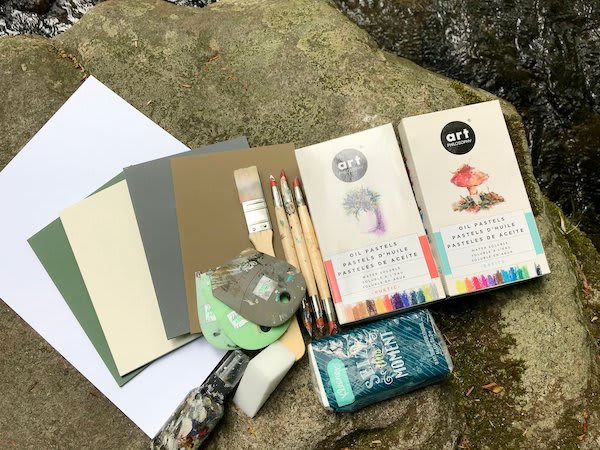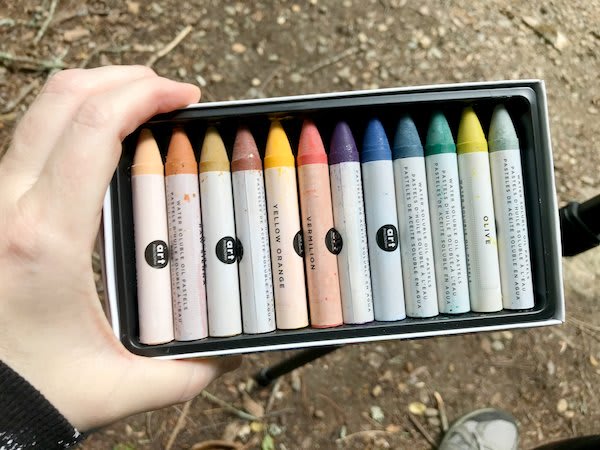The Solitude and Safety of Plein Air Painting
If you’re like me and you love both creating and being outdoors, I encourage you to try painting “en plein air”. It’s a French phrase that loosely means putting brush to canvas “out in the open air” rather than in a studio. Although plein air painting has seemed especially timely over the last year, as the coronavirus pandemic forced social distancing upon us, its roots go way back.
A Very Brief History of Plein Air Painting
You could argue that cave dwellers were the first plein air painters. But historians date plein air to the late 1800s, when the Impressionism movement first took hold among a group of French painters you may have heard of, including Claude Monet, Alfred Sisley, and Pierre-Auguste Renoir.
However, it was a not-so-famous American artist, John Rand, who opened wide the doors to plein air painting. Not through his art, but through an invention: paint in a tube. Suddenly paint became portable, enabling artists to more easily haul their supplies outdoors.
Speaking of America, we have our own plein air history. The Hudson River School was made of American landscape artists who wandered into the woods, mountains, and valleys of New York and New England to paint inspiring natural scenes. Some ventured farther to produce stunning images of the American West. The documentary “Outside the Lines” beautifully tells this story.
Among my favorite plein air painters are Monet; early 20th-century California artist Mary DeNeale Morgan; and current artists Stephen T. Datz of Colorado and Carolyn Lindsey of New Mexico.
My Plein Air Backpack
I was introduced to plein air painting in Texas during my 20s. While taking beginner oil painting lessons from Brigitte Woolsley — a former courtroom artist who now depicts western landscapes — we often painted outdoors, which I thoroughly enjoyed. And though I put painting aside for several years to focus on Frame Destination and my academic education, I’ve now got time to pursue plein air painting.
A couple years ago, I moved to the Black Mountains of western North Carolina with my husband and business partner, Mark Rogers. I’ve always loved hiking, but I’ve got a few minor back issues, so my plein air backpack needs to be as lightweight as possible.
Below are my top 10 essential supplies for painting outdoors in a mountainous region. Revisiting the same places multiple times is a great way to figure out exactly what you need to bring — and the best times to come and paint.
Soho Urban Artist Plein Air Easel
When I’m working outdoors with an easel, I typically sit on a rock. Sometimes I just stand. The Soho Urban Artist Plein Air Easel is the best one I’ve found in terms of portability, ease of use, and height adjustments.
Pastelbord or Multimedia Artboard
For plein air painting, I prefer to use oil pastels and I love lightweight Pastelbord or Multimedia Artboard panels. They accept multiple layers of oil pastels and water blending.

Water-Soluble Oil Pastels in Basic and Rustic
I’ve been using Sennelier oil pastels in my studio work for years. I recently discovered Art Philosophy’s water-soluble oil pastels and have been using them in my plein air work along with Catalyst Art Tools to create "sgraffito" effects. See more about this in #4.

Catalyst Art Tools and/or Sculpting Tools
As I was saying above, you can produce sgraffito effects by adding a few layers of oil pastel, softening the layers with a brush/tissue and water, then layering on more pastel and use Catalyst Art Tools or sculpting tools to create marks.
The rest of my list should be self-explanatory:
Large Brush and/or Portable Brushes
Spray Bottle or Small Container for Water
Tissues, Paper Towels, or Rags
Water, Snacks, and a Resealable Bag to Hold Waste
Hat, Sunblock, and an Emergency Blanket.
Business Cards—Keep reading for the why behind this one.
Plein Ol’ Common Sense
Painting outdoors requires awareness of your surroundings no matter where you’re located. These are a few practical safety tips I’ve learned over while hiking/painting in the mountains.
Let someone know where you’ll be painting, and be specific. For example, “I’m going on ___ trail and I plan to be back around ___ time.” Also, bring a buddy if possible.
Research the wildlife in your area. In western North Carolina, we have a large population of black bears, which I encounter on an almost daily basis both at home and while out hiking. I carry bear spray and stay aware of my environment at all times. Here are some tips on what to do if you encounter a bear.
Wear sunscreen and/or a hat and long sleeves if possible, and use insect repellent.
Prioritize water and food over extra art supplies.
Check your local weather before venturing out.
Bring a map and/or a compass in case the cell service is sketchy.
Human Encounters
During your plein air painting forays, you may meet other walkers, hikers, and nature lovers who are interested in your work. If you are seeking solitude, don’t feel obligated to engage with people commenting on your painting, aside from a polite “thank you.” However, if you choose, you could take this time to practice talking about your work and maybe even gain a potential customer. I always carry business cards and have made customer contacts and sometimes sales while plein air painting.
Plein Air Organizations
Outdoor Painter, the home of Plein Air magazine, has a weekly newsletter with excellent content. I took their Plein Air Live Beginner’s Day 2021 Online Workshop as a refresher and learned so much. If you’re interested in learning about plein air painting or you’d like to network and enter competitions, I highly recommend signing up for their newsletter or getting a subscription to Plein Air Magazine for tips, tools, and contests.
By now I hope you’re feeling inspired to get outdoors, breathe in some fresh air, and create. Feel free to share your art with us — we’d love to see your work! For ideas on how to frame your art once it's ready for the spotlight, see our new options for plein air painters.
Last Updated November 2, 2021